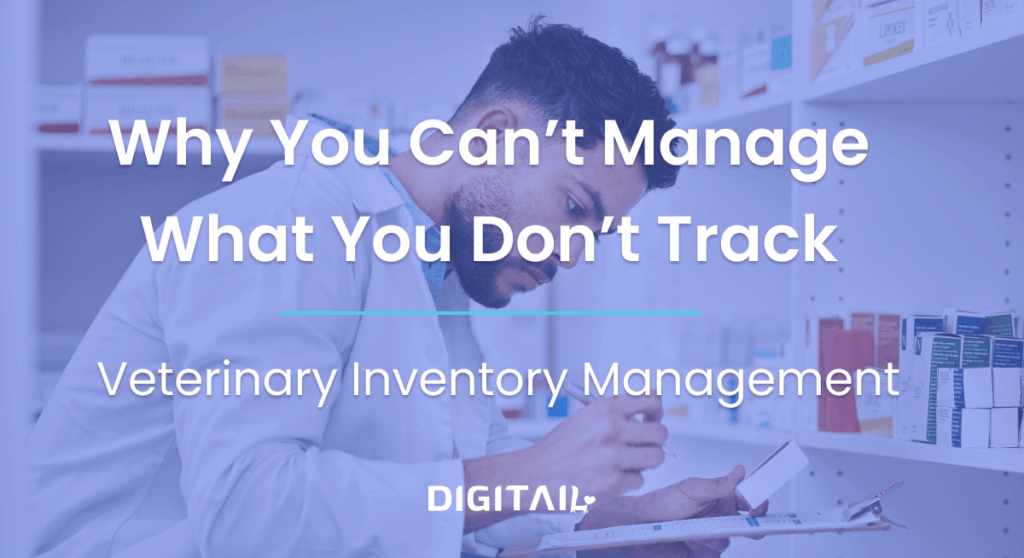- Artificial Intelligence
- Pet Care
- Team & Client Retention
- Veterinary Business
- Veterinary Practice Management

You Can’t Manage What You Can’t Track: A Better Way to Handle Inventory
Let’s be honest, “inventory management” is probably not the phrase that gets your heart racing when you think about veterinary medicine. It’s often a thankless, time-consuming task that feels like a necessary evil. The endless cycle of counting, ordering, and tracking products can feel like a chaotic mess of spreadsheets, clipboards, and last-minute scrambles.
But what if we told you that mastering your inventory is one of the single most powerful things you can do for your clinic’s profitability, efficiency, and even quality of patient care?
The Hidden Cost of Poor Inventory Management in Veterinary Practices
The average veterinary practice carries between $50,000 and $150,000 in inventory at any given moment. That’s not revenue. That’s capital sitting on shelves, waiting to be used or expire.
And most practices have no real idea what they actually have.
Consider a clinic carrying $85,000 in inventory. With better tracking, that same clinic might discover it could operate just as effectively with $55,000. That’s $30,000 in cash that could be freed up for equipment, staff development, or debt reduction.
But inventory isn’t just sitting there passively. It’s actively costing money. Storage space, insurance, expiration, damage, shrinkage… Industry estimates suggest veterinary practices spend 20-30% of their inventory’s value annually just to maintain it. On $85,000, that’s over $21,000 a year.
Why Veterinary Clinics Struggle With Inventory Control
Most veterinarians didn’t get into this profession to manage spreadsheets. They’re wired to treat, not tally. Nobody opens a practice dreaming about inventory management. So practices handle the urgent and defer the important. That dog needs surgery now. That cat needs bloodwork now. The inventory? That can wait.

The problem compounds because veterinary clinics aren’t retail businesses. Products might be dispensed to clients, used during procedures, given as samples, or administered during treatment. Each pathway requires different tracking. Miss one, and the counts are off.
Add the sheer variety—500-800 SKUs for small clinics, 2,000+ for larger practices—each with its own supplier, ordering minimums, lead time, and expiration considerations. And the stakes are higher: running out of the medication a critical patient needs isn’t just inconvenient.
Understanding Inventory Turnover
Inventory turnover measures how many times per year a veterinary practice completely sells and replaces its stock. This is your key performance indicator.
A clinic with $50,000 in inventory and $500,000 in annual cost of goods sold is turning inventory 10 times a year—healthy for veterinary practices.
But if that same clinic carries $100,000 in inventory with the same COGS, it’s only turning inventory 5 times. Half as efficient. Twice as much capital is tied up.
Higher turnover rates aren’t always better. Excessively high turnover might indicate frequent stockouts and lost sales opportunities. Too low, and capital is unnecessarily tied up with increased risk of expiration and waste.
Most successful practices aim for 8-12 turns per year. Yet most practices have no idea what their number is because calculating turnover requires knowing both COGS and average inventory value accurately. And that requires actual tracking.
Best Practices for Smarter Veterinary Inventory Management
Veterinary clinics face unique inventory challenges, from unpredictable case loads to hundreds (sometimes thousands) of SKUs, varying expiry dates, and inconsistent supplier terms. But by applying tried-and-true inventory principles adapted from the retail and human medical industries, clinics can take back control.
Here are several best practices that modern veterinary practices can implement today:
1. Assign a Veterinary Inventory Manager for Clear Accountability
If everyone “kind of helps,” no one’s truly responsible. Inventory must be someone’s actual responsibility. Designate an inventory manager with clear authority and accountability.
2. Use ABC Analysis to Prioritize Inventory Items by Value
Not all inventory deserves equal attention. The ABC classification method categorizes items based on their value contribution:
| Category | Class A (Red) | Class B (Yellow) | Class C (Green) |
| Priority | Never run out | Lower priority but important | Order as needed |
| % of Inventory Items | 20% | 30% | 50% |
| % of Revenue | 70-80% | 15-20% | 5-10% |
| Control Level | Strict control | Moderate control | Minimal control |
| Count Frequency | Weekly | Monthly or quarterly | Quarterly or semi-annually |
| Examples | Specialty drugs, vaccines, flea/deworming products, NSAIDs, antibiotics | Prescription diets, chronic medications | Cotton balls, gauze, urine sampling kits, blood transfusion sets |
This classification helps reduce shrinkage and over-ordering while ensuring mission-critical items are always available.
To categorize your inventory, run a 12-month sales report from your practice management software to account for seasonal variations. Color-code physical products with stickers or labels so staff can quickly identify and prioritize critical items.
3. Conduct Physical Inventory Counts Regularly to Catch Discrepancies
Even with digital systems, periodic physical verification remains essential. High-value items warrant monthly counts. Comprehensive audits should occur quarterly or semi-annually.
Discrepancies between physical counts and system records signal problems, whether theft, administrative errors, or unrecorded damage. Track patterns to identify root causes.
How Veterinary PIMS Improves Inventory Accuracy
Once solid processes are in place, technology multiplies effectiveness.
Today’s veterinary Practice Management Systems integrate inventory directly into clinical workflows, automatically updating stock levels as products are used.
The key differentiator of modern PIMS is real-time tracking. When a technician dispenses medication during an appointment, inventory decrements immediately. When products are added during receiving, quantities update instantly. This eliminates the lag time inherent in manual systems where today’s decisions rely on yesterday’s data.
Barcode scanning eliminates manual entry errors. When shipments arrive, staff scan items directly into inventory faster, more accurately, and less tediously. In Digitail, setting up barcodes is straightforward: associate unique codes to products in the Product Directory, then scan instead of typing for receiving, checkout, or dispensing.

Modern inventory reporting transforms data into actionable insights. Digitail’s Stock Movement Report tracks:
- Opening and closing stock values for any period
- Cost of Goods Sold (COGS) by product and category
- Detailed movement for purchases, sales, and adjustments
- Net Realizable Value for financial reporting
Filter by category, AAHA codes, supplier, or date range. Export to Excel for custom analysis.
For example, a clinic might discover through reporting that they’re ordering surgical gloves weekly in small quantities, paying premium prices for rush shipping. Switching to monthly orders and negotiating better prices could reduce costs by 30% or more, with no change in actual usage.
Intelligence-Driven Ordering Optimizes Stock Levels
While tracking is essential, optimization requires intelligence. Specialized inventory management tools that integrate with practice management software analyze order history and sales velocity to create dynamic reorder recommendations based on actual usage patterns.

Digitail’s integration with Inventory Ally combines order history and sales data for accurate, data-driven inventory management. Rather than relying on static par levels that may be outdated, the system continuously adjusts based on usage patterns. It provides critical insights into KPIs including:
- Cost of Goods Sold (COGS) for accurate profit margin analysis
- Formulary redundancy identification to eliminate duplicate products
- Shrink and loss reporting that highlights where inventory disappears
- Margin analytics showing which products actually drive profitability
The system prioritizes items based on value and sales volume, providing precise recommendations on what to order and in what quantities, saving time and resources while optimizing inventory costs.
This type of analysis can reveal patterns invisible to manual management, such as carrying multiple similar antibiotics when one or two would suffice. Identifying and cutting such redundancy frees up both cash and shelf space.
For Canadian clinics, Digitail also integrates directly with CDMV—automating ordering, pricing updates, and inventory sync for a fully connected workflow.
The Financial Benefits of Using Veterinary Inventory Software
When practices implement proper inventory management, the financial impact shows up quickly:
- Improved Cash Flow: Capital freed up for growth initiatives, emergency reserves, or debt reduction
- Reduced Carrying Costs: Lower inventory levels proportionally reduce costs and free up space
- Decreased Waste: Better tracking catches approaching expirations; practices commonly reduce waste by 40-60% in the first year
- Increased Productivity: Automated systems redirect hours to patient care and client service
- Higher Profitability: Comprehensive inventory management can improve profitability by 2-5% without changing service offerings
- Enhanced Client Satisfaction: Consistently having needed products builds trust and loyalty
The principle is straightforward: practices can’t manage what they can’t track. In veterinary medicine, where margins are tight and competition intensifies, invisible inventory costs represent an entirely solvable error.
The practices thriving today treat inventory management as a core competency. They measure what matters, implement proven practices, and leverage technology to gain visibility and control.
Every practice’s inventory is already telling a story about efficiency and profitability. The only question is whether anyone is listening.
Discover the Only All-in-one Software for Animal Hospitals
From appointments to invoicing, Digitail centralizes everything in one easy-to-use platform. Built for modern veterinary practices, trusted by growing teams. Schedule a personalized demo and discover why more clinics are choosing Digitail.




